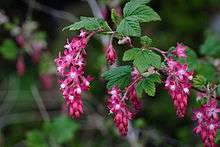Ribes sanguineum
Ribes sanguineum, the flowering currant, redflower currant, or red-flowering currant, is a North American species of flowering plant in the family Grossulariaceae, native to western United States and Canada (British Columbia, Washington, Idaho, Oregon, California),[2][3][4][5] but widely cultivated and naturalized throughout temperate Europe and Australasia.[6]
| Ribes sanguineum | |
|---|---|
 | |
| Scientific classification | |
| Kingdom: | Plantae |
| Clade: | Tracheophytes |
| Clade: | Angiosperms |
| Clade: | Eudicots |
| Order: | Saxifragales |
| Family: | Grossulariaceae |
| Genus: | Ribes |
| Species: | R. sanguineum |
| Binomial name | |
| Ribes sanguineum Pursh 1813 | |
| Synonyms[1] | |
| |
Description
It is a deciduous shrub growing to 2 m (7 ft) tall and broad.
The bark is dark brownish-grey with prominent paler brown lenticels.
The leaves are 2–7 cm (1–3 in) long and broad, palmately lobed with five lobes; when young in spring, they have a strong resinous scent.
The flowers are produced in early spring at the same time as the leaves emerge, on dangling racemes 3–7 cm (1–3 in) long of 5–30 flowers; each flower is 5–10 mm (0.20–0.39 in) in diameter, with five red or pink petals.
The fruit is a dark purple oval berry about 1 cm (0.5 in) long, edible but with an insipid taste.[7]
The Latin specific epithet sanguineum means “blood-red”[8]
Varieties
| Image | Subspecies | Description | Distribution |
|---|---|---|---|
 | Ribes sanguineum var. glutinosum | Racemes with 15-40 pendant flowers, sepals pink to white. | Oregon and California south to Santa Barbara County, 0-2300 m[9] |
| Ribes sanguineum var. sanguineum[10] | Racemes with 5-15(-20) erect to stiffly spreading flowers, sepals red. | California, Idaho, Oregon, and Washington, 1300-2400 m[11] | |
Cultivation
Ribes sanguineum was introduced into cultivation by 19th century Scottish botanist David Douglas. It and its varieties and cultivars are popular garden shrubs, valued for their brightly colored and scented flowers in early spring, and birds and habitat support.
Numerous cultivars have been selected with flowers ranging from white to dark red. The following cultivars have gained the Royal Horticultural Society’s Award of Garden Merit:-[12]
Gallery
- Habit
 Fruits
Fruits- Spring buds on R. sanguineum var. glutinosum
.jpg)
_4.jpg) Bumblebee on flowers
Bumblebee on flowers
References
- The Plant List, Ribes sanguineum Pursh
- Calflora taxon report, University of California: Ribes sanguineum
- Plants of British Columbia: Ribes sanguineum
- Biota of North America Program 2014 county distribution map
- Turner Photographics, Ribes sanguineum - Wildflowers of the Pacific Northwest includes photos, description, partial distribution map
- "Ribes sanguineum". Germplasm Resources Information Network (GRIN). Agricultural Research Service (ARS), United States Department of Agriculture (USDA).
- RHS A-Z encyclopedia of garden plants. United Kingdom: Dorling Kindersley. 2008. p. 1136. ISBN 1405332964.
- Harrison, Lorraine (2012). RHS Latin for Gardeners. United Kingdom: Mitchell Beazley. ISBN 184533731X.
- "Ribes sanguineum var. glutinosum in Flora of North America @ efloras.org". eFloras.org Home. Retrieved 2019-08-22.
- "Ribes sanguineum". CalFlora. Retrieved 5 January 2010.
- "Ribes sanguineum var. sanguineum in Flora of North America @ efloras.org". eFloras.org Home. Retrieved 2019-08-22.
- "AGM Plants - Ornamental" (PDF). Royal Horticultural Society. July 2017. p. 87. Retrieved 9 October 2018.
- "RHS Plantfinder - Ribes sanguineum 'Koja'". Retrieved 9 October 2018.
- "'Poky's Pink'". RHS. Retrieved 19 March 2020.
- "RHS Plantfinder - Ribes sanguineum White Icicle = 'Ubric'". Retrieved 9 October 2018.
External links
| Wikimedia Commons has media related to Ribes sanguineum. |
- Jepson Flora Project: Ribes sanguineum
- Ribes sanguineum — Calphotos Photo gallery, University of California